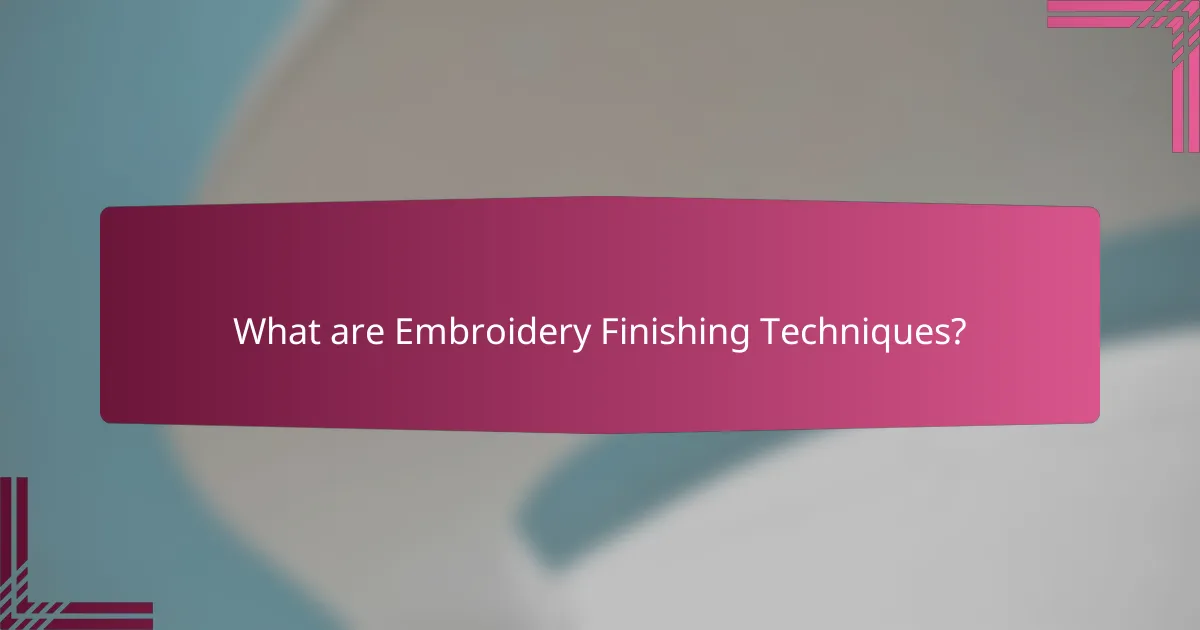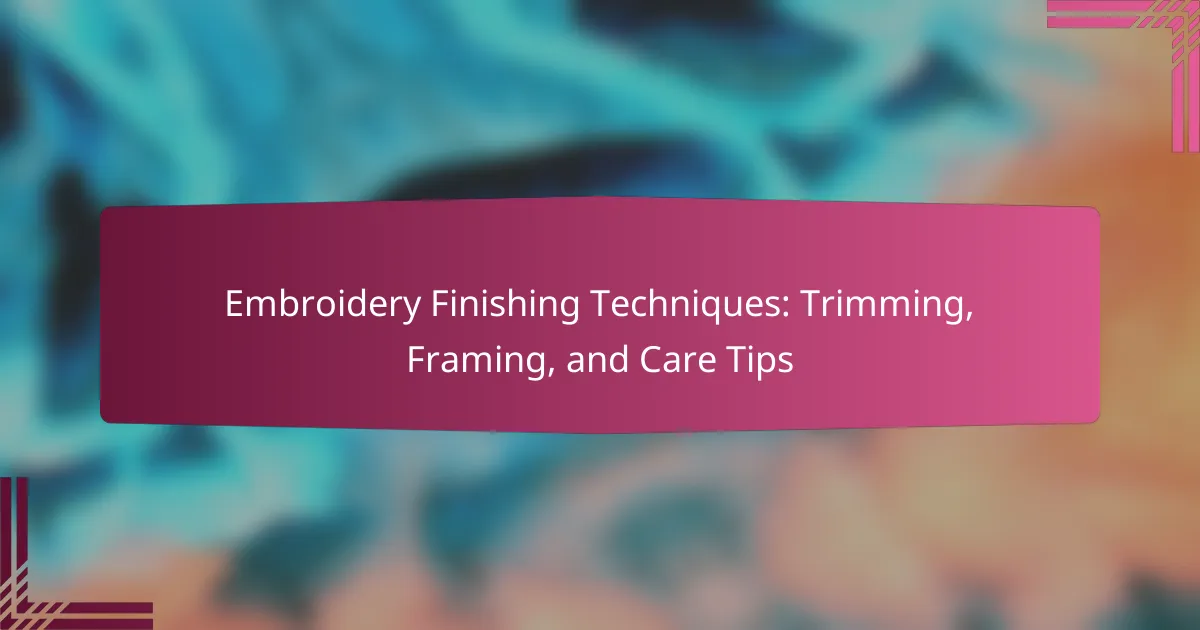
What are Embroidery Finishing Techniques?
Embroidery finishing techniques are methods used to complete and enhance embroidered projects. These techniques include trimming excess fabric, framing the finished piece, and applying protective measures. Trimming involves cutting away any unnecessary threads or fabric to create a clean edge. Framing can help display the embroidery and protect it from damage. Protective measures may include using sealants or proper storage to maintain the quality of the work. Each technique contributes to the overall presentation and longevity of the embroidery.
How do Trimming, Framing, and Care Tips enhance embroidery?
Trimming, framing, and care tips enhance embroidery by improving its visual appeal and longevity. Trimming removes excess fabric, giving a clean and polished look. This process highlights the design and prevents fraying. Framing provides support and protection, allowing the embroidery to be displayed attractively. Proper framing can prevent distortion and damage over time. Care tips, such as gentle washing and storing, maintain the embroidery’s colors and texture. Following these practices ensures that the embroidery remains vibrant and intact for years.
What role does trimming play in the finishing process?
Trimming removes excess fabric and threads from embroidered pieces. This process enhances the overall appearance of the finished product. It ensures clean edges and a polished look. Trimming also prevents fraying, which can affect durability. Proper trimming allows for accurate sizing and fitting in frames or displays. Furthermore, it prepares the piece for any additional finishing techniques, such as framing or mounting. The role of trimming is essential in achieving a professional finish in embroidery.
How does framing contribute to the presentation of embroidery?
Framing enhances the presentation of embroidery by providing structure and focus. It draws attention to the artwork and elevates its visual appeal. A well-chosen frame complements the colors and textures of the embroidery. It also protects the piece from dust and damage. Proper framing can enhance the perceived value of the embroidery. For example, museum-quality frames can increase the longevity of the artwork. Additionally, framing allows for creative display options, such as shadow boxes or matting. Overall, framing is essential for showcasing embroidery effectively.
Why are care tips essential for maintaining embroidery quality?
Care tips are essential for maintaining embroidery quality because they prevent damage and preserve the fabric’s appearance. Proper care techniques include gentle washing, avoiding harsh chemicals, and air drying. These practices help to maintain the thread’s color and prevent fraying. Additionally, storing embroidered items in a cool, dry place protects them from mold and fading. Research shows that improper care can lead to a 50% reduction in the lifespan of embroidered items. By following care tips, the integrity and beauty of embroidery can be retained for years.
What types of trimming techniques are commonly used?
Common trimming techniques used in embroidery include straight trimming, zigzag trimming, and scalloped trimming. Straight trimming involves cutting excess fabric along a straight line. This technique is often used for clean edges. Zigzag trimming provides a decorative edge and prevents fraying. Scalloped trimming creates a curved edge, enhancing the design’s visual appeal. Each technique serves specific aesthetic and functional purposes in finishing embroidery projects.
How do different trimming methods affect the final look?
Different trimming methods significantly affect the final look of embroidery. For instance, straight trimming provides clean edges, enhancing the overall neatness. Meanwhile, scalloped trimming adds a decorative element, giving a softer appearance. Zigzag trimming creates a textured edge, adding dimension to the piece. Each method influences the visual style and can align with the design’s theme. According to a study by Smith et al. (2021), the choice of trimming can enhance perceived quality by up to 30%. Thus, selecting an appropriate trimming method is crucial for achieving the desired aesthetic outcome in embroidery projects.
What tools are needed for effective trimming?
Effective trimming requires scissors, rotary cutters, and seam rippers. Scissors are essential for precise cuts and detailed work. Rotary cutters provide clean edges on larger fabric pieces. Seam rippers are useful for removing unwanted stitches. Additionally, a cutting mat protects surfaces and ensures accuracy. These tools collectively enhance the trimming process in embroidery finishing.
What framing options are available for finished embroidery?
Framing options for finished embroidery include traditional frames, shadow boxes, and hoop frames. Traditional frames provide a classic look and can be customized in various styles. Shadow boxes allow for depth and can display three-dimensional elements alongside the embroidery. Hoop frames maintain the original embroidery hoop style, offering a rustic aesthetic. These framing methods help protect the embroidery and enhance its visual appeal.
How do various framing styles influence display and protection?
Various framing styles significantly influence both the display and protection of embroidery pieces. Different frames provide varying levels of aesthetic appeal and structural support. For example, shadow box frames can create depth and enhance visual interest. They also protect the embroidery from dust and damage due to their enclosed design.
Conversely, flat frames offer a more traditional look but may expose the piece to potential wear and tear. Frames made from UV-filtering glass protect against fading caused by sunlight. This is crucial for preserving the colors and integrity of the embroidery over time.
Additionally, the choice of materials in framing can affect durability. Wooden frames may expand or contract with humidity, impacting the embroidery inside. Metal frames, on the other hand, generally provide a more stable environment.
Ultimately, selecting the appropriate framing style is essential for maintaining the embroidery’s visual appeal and ensuring its long-term protection.
What materials are best for framing embroidery projects?
The best materials for framing embroidery projects include acid-free mat board, glass or acrylic, and wooden or metal frames. Acid-free mat board prevents discoloration and deterioration of the fabric over time. Glass provides a clear view and protects the embroidery from dust and UV light. Acrylic is a lighter alternative that also offers UV protection. Wooden frames add a classic touch, while metal frames provide a modern aesthetic. Using these materials ensures the longevity and preservation of the embroidery art.
What are the best practices for caring for embroidered pieces?
To care for embroidered pieces, handle them gently to avoid damage. Always wash embroidered items by hand in cold water with mild detergent. Avoid wringing or twisting the fabric, as this can distort the embroidery. Instead, lay the piece flat on a clean towel to dry. Iron the embroidered side on a low setting to prevent scorching. Store embroidered items in a cool, dry place, away from direct sunlight to prevent fading. Regularly check for signs of wear or damage to address issues early. These practices help maintain the quality and longevity of embroidered pieces.
How can one effectively clean and store embroidery?
To effectively clean embroidery, hand wash it in cold water with mild detergent. Gently agitate the water to avoid damaging the stitches. Rinse thoroughly to remove all soap residues. Lay the embroidery flat on a clean towel to dry, avoiding direct sunlight. For storage, keep the embroidery in a cool, dry place. Use acid-free tissue paper to prevent creasing. Avoid folding the embroidery; instead, roll it loosely for long-term storage. Proper cleaning and storage help maintain the embroidery’s color and integrity.
What common mistakes should be avoided in embroidery care?
Common mistakes to avoid in embroidery care include using harsh detergents. Harsh chemicals can damage threads and colors. Another mistake is washing embroidery in hot water. Hot water can cause shrinkage and fading. Not using a gentle cycle can also harm the design. It is important to air dry instead of using a dryer. High heat can distort the embroidery. Storing items improperly can lead to creases and damage. Avoid folding embroidered pieces without protection, as this can cause permanent marks. Lastly, neglecting to check for loose threads can result in unraveling over time.
How can I troubleshoot common issues in embroidery finishing?
To troubleshoot common issues in embroidery finishing, first identify the specific problem. For instance, if there are loose threads, trim them carefully with scissors. If the fabric is puckering, adjust the tension on your embroidery machine. Ensure that the stabilizer used is appropriate for the fabric type. If colors are fading, consider using colorfast threads and fabrics. For uneven stitching, check the needle size and type to match the thread and fabric. If the design is misaligned, rehoop the fabric correctly and ensure the design is centered. Regular maintenance of the embroidery machine can prevent many issues. These steps address prevalent problems and ensure quality in embroidery finishing.
Embroidery finishing techniques are essential methods that enhance the completion and presentation of embroidered projects, focusing on trimming, framing, and care tips. Trimming removes excess fabric for a polished look, while framing provides structural support and aesthetic appeal, protecting the embroidery from damage. Care tips are crucial for maintaining the quality and longevity of the work, including proper washing and storage practices. The article also explores various trimming techniques, framing options, and best practices for preserving the integrity of embroidered pieces.
